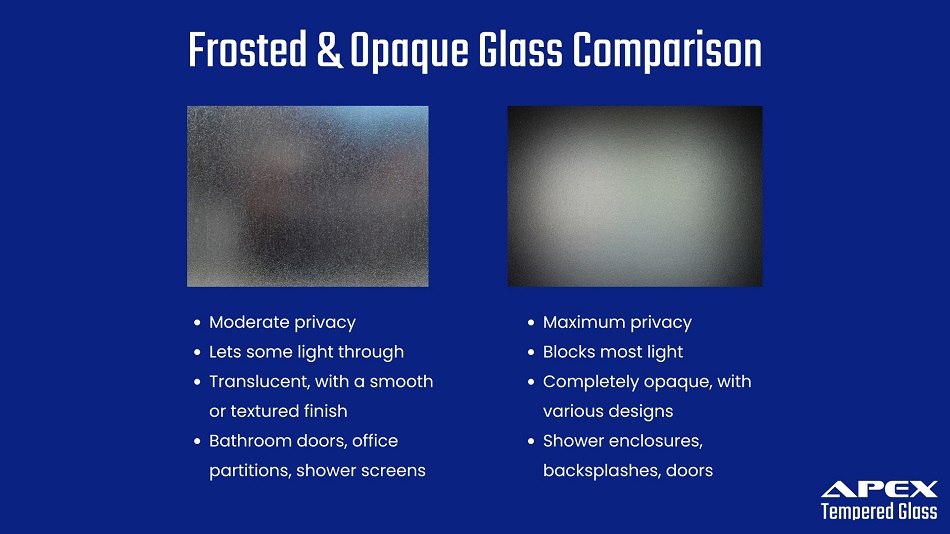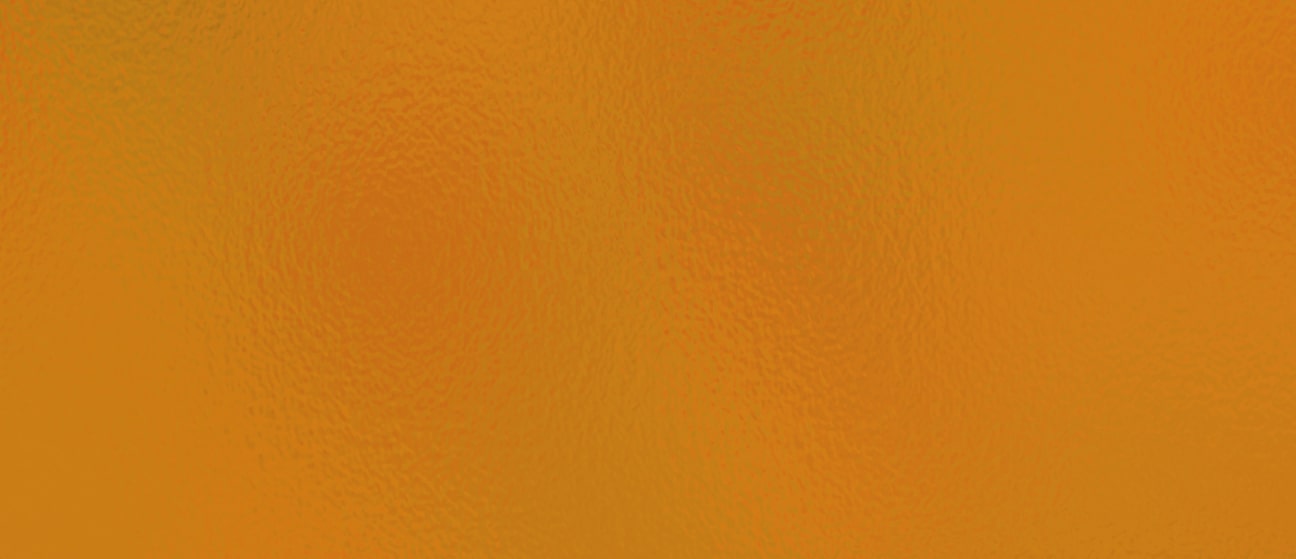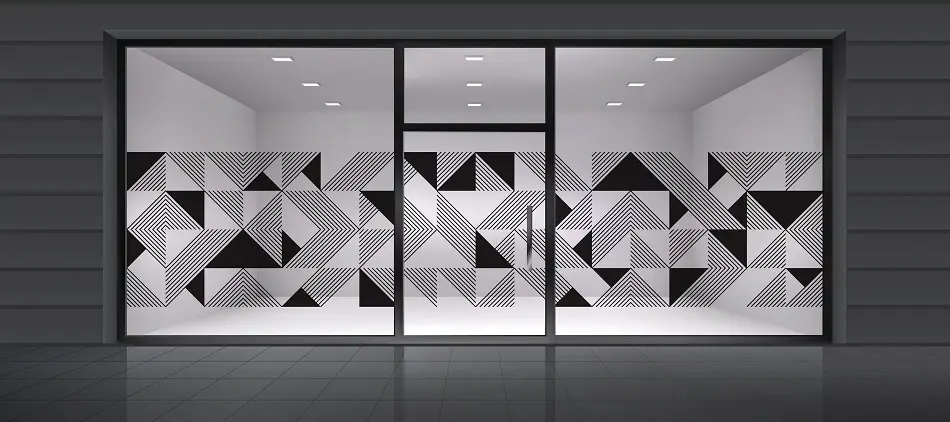Frosted vs. Opaque Glass: What Is the Difference?






Opaque and frosted glass are both types of obscure glass that offer varying degrees of privacy and light transmission. While often used interchangeably, these two terms represent distinct glass treatments with different characteristics and applications. Apex Tempered Glass aims to clarify the differences between frosted and opaque glass to help you make an informed decision for your home or business.
To help visualize the key differences between frosted and opaque glass, consider the following comparison:
| Feature | Frosted Glass | Opaque Glass |
|---|---|---|
| Privacy | Moderate | Maximum |
| Light Transmission | Allows light to pass through | Minimal light transmission |
| Appearance | Translucent, often with a smooth or textured finish | Completely opaque, with various textures, colors, or patterns |
| Common Applications | Bathroom doors, office partitions, shower screens | Shower enclosures, backsplashes, doors |
When choosing between frosted and opaque glass, consider the desired level of privacy, light requirements, and aesthetic preferences. If you need to maintain some natural light while obscuring vision, frosted glass is an excellent option. If you’re after a glass not allowing light and providing complete privacy, opaque glass is the way to go.
Frosted glass is created through a process called acid etching or sandblasting, which creates a pitted surface on the glass. This surface diffuses light while obscuring vision, resulting in a soft, translucent appearance. Frosted glass allows a moderate amount of light to pass through while maintaining privacy. Its elegant and understated aesthetic makes it a popular choice for various applications.
Commonly used in bathroom doors, shower screens, and office partitions, frosted glass offers a balance of privacy and light. Its versatility allows for customization with designs, logos, or patterns while preserving its translucent quality.
The types are based the two primary manufacturing methods – sandblasting and acid etching.
As the name suggests, sandblasted glass is created by propelling tiny abrasive particles at high speed onto the glass surface. This process creates a frosted appearance by roughening the glass. The intensity of the sandblasting can be controlled to achieve varying levels of opacity.
Common residential and commercial applications include glass railings, walls, and decorative accents.
Acid etching involves applying a chemical solution to the glass surface, gradually eroding it to create a frosted effect. This method often produces a smoother, more uniform finish compared to sandblasting. Acid-etched glass is typically more resistant to scratches and fingerprints, making it a popular choice for high-traffic areas.
Common applications include bathroom windows, office doors, and interior design elements.

Ready to transform your Illinois or Wisconsin space with the perfect glass solution? Let's work together to bring your vision to life.
Opaque glass, on the other hand, is designed to completely block visibility. This type of obscure glass offers maximum privacy by preventing any light or image from passing through. It’s often textured, colored, or patterned to create a visually interesting surface.
Opaque glass is ideal for applications where complete privacy is essential, such as shower enclosures, backsplashes, and certain types of doors. While it effectively blocks light, it can also create a sense of seclusion in a room if used extensively.
Let’s explore the different types of opaque glass available:

Can be a type of opaque glass and offers an infinite array of design options. From classic geometric patterns to intricate floral motifs, there’s a pattern to suit every style. The complexity of the pattern directly impacts the level of privacy. Detailed patterns provide maximum obscurity, while simpler designs allow for more light to pass through.
Patterned glass can be used to create stunning focal points in a room. A patterned glass door can serve as a welcoming entryway, while a patterned glass window can add character to a living space. Additionally, patterned glass can be incorporated into furniture, backsplashes, or even shower enclosures for a touch of elegance.
Offers a myriad of design possibilities. From subtle ripples that create a shimmering effect to bold, geometric patterns that make a statement, textured glass can transform a space. The depth and complexity of the texture determine the level of opacity. For instance, deeply etched patterns provide maximum privacy, while lighter textures offer a softer, more translucent look.
Textured glass can be used creatively in interior design. Consider a textured glass backsplash in a kitchen to add visual interest and protect walls from splatters. Or, incorporate textured glass into furniture pieces like table tops or cabinet doors for a unique and modern touch.
Colored opaque glass is not limited to solid hues. It can also incorporate gradients, patterns, or even images for a truly customized look. The color intensity affects the level of opacity, with darker shades providing more privacy.
Beyond its aesthetic appeal, colored glass can be used to manipulate light and create mood. For example, a blue-tinted glass can evoke a calming atmosphere, while a red-tinted glass can add energy to a space. Consider using colored glass in windows, doors, or as accent pieces to infuse personality into your environment.
Understanding the differences between frosted and opaque glass is crucial in selecting the right glass for your project. Frosted glass offers a balance of privacy and light, while opaque glass provides maximum privacy and light control. By carefully considering your needs and preferences, you can make an informed decision that enhances both the functionality and aesthetics of your space.
If you’re unsure about which type of glass would best suit your project in Illinois or Wisconsin, Apex Tempered Glass‘s team of experts is ready to assist you. Reach out to us today to discuss your vision and let us help you bring it to life with our custom glass solutions.
Finance and Operations
Nina leads Apex Tempered Glass, a company specializing in manufacturing all types of glass. Known for her strategic expertise and exceptional operational performance, Nina is committed to providing innovative solutions for any glass-related issue.

Ready to elevate your home or business? Our expert team in Chicago can help you select the perfect glass solution.
*We serve Illinois & Wisconsin.